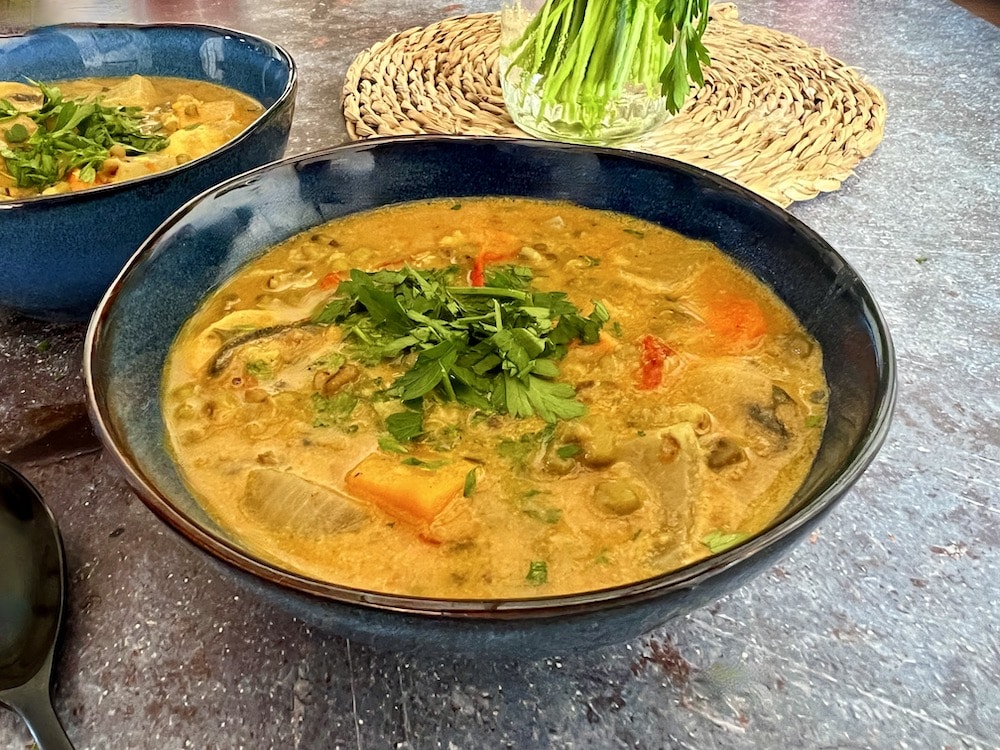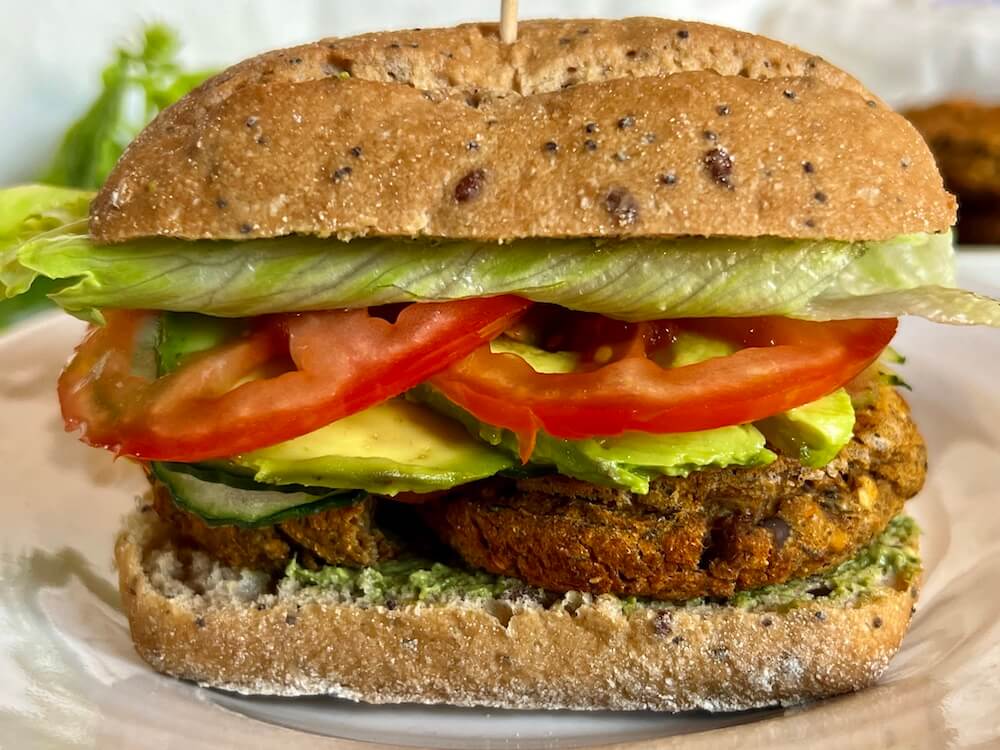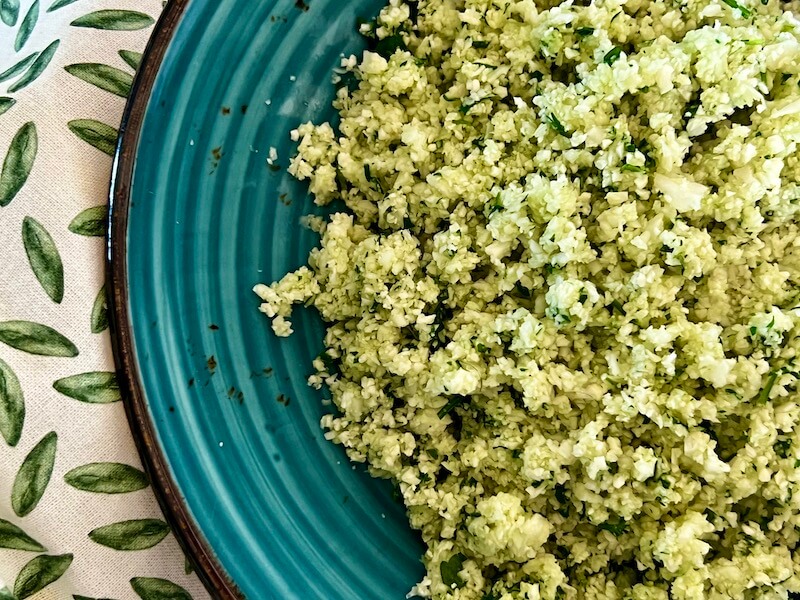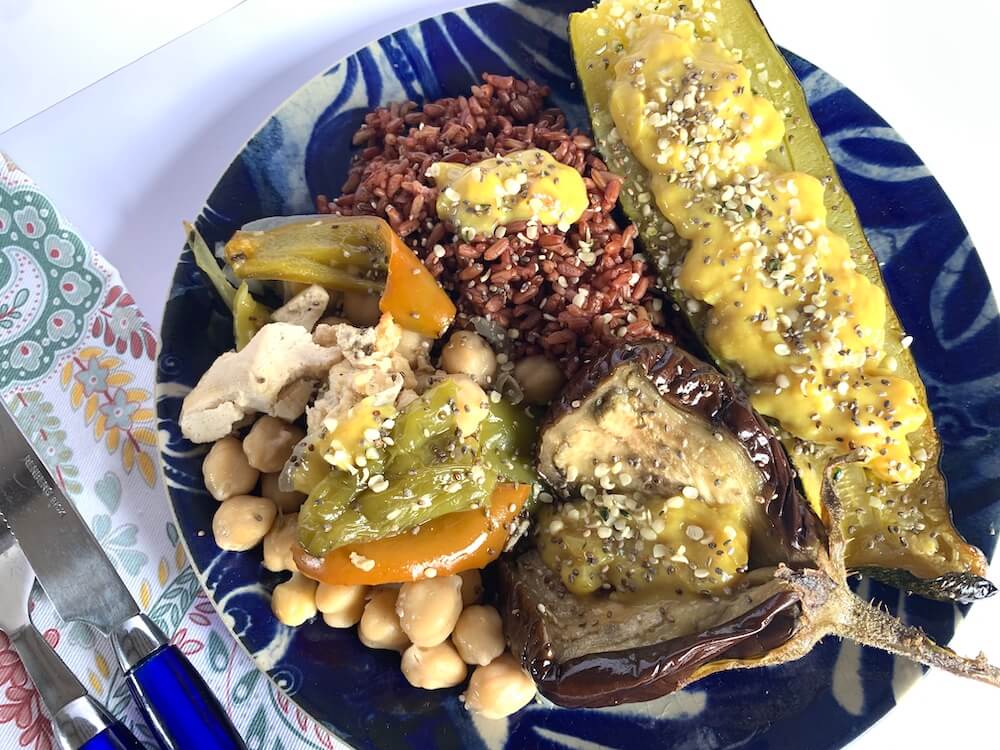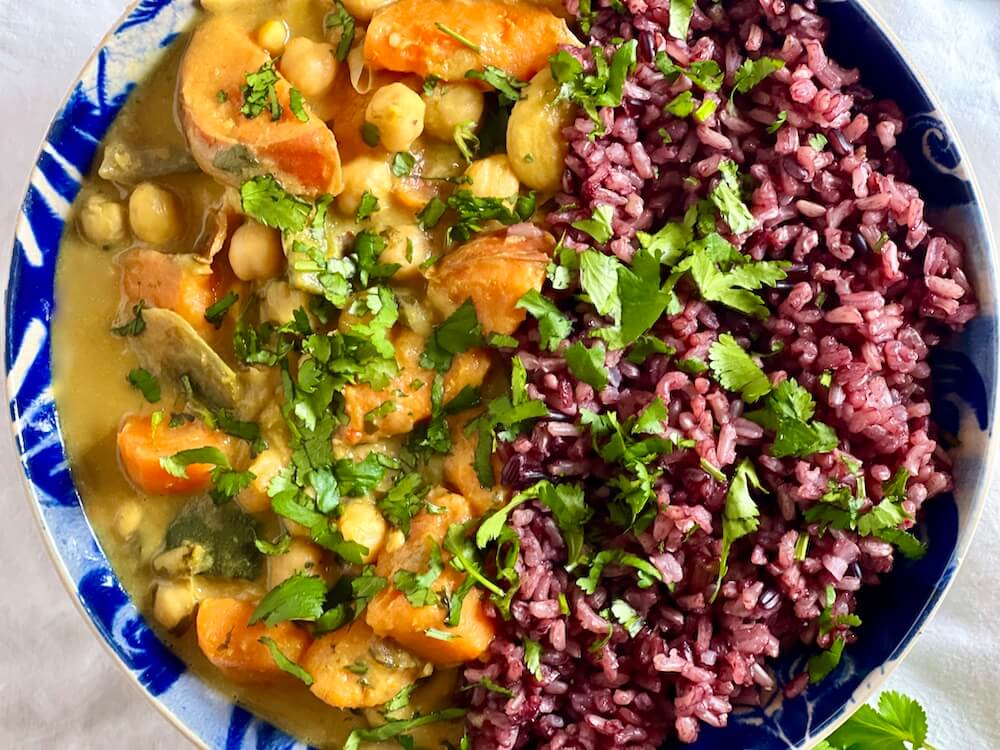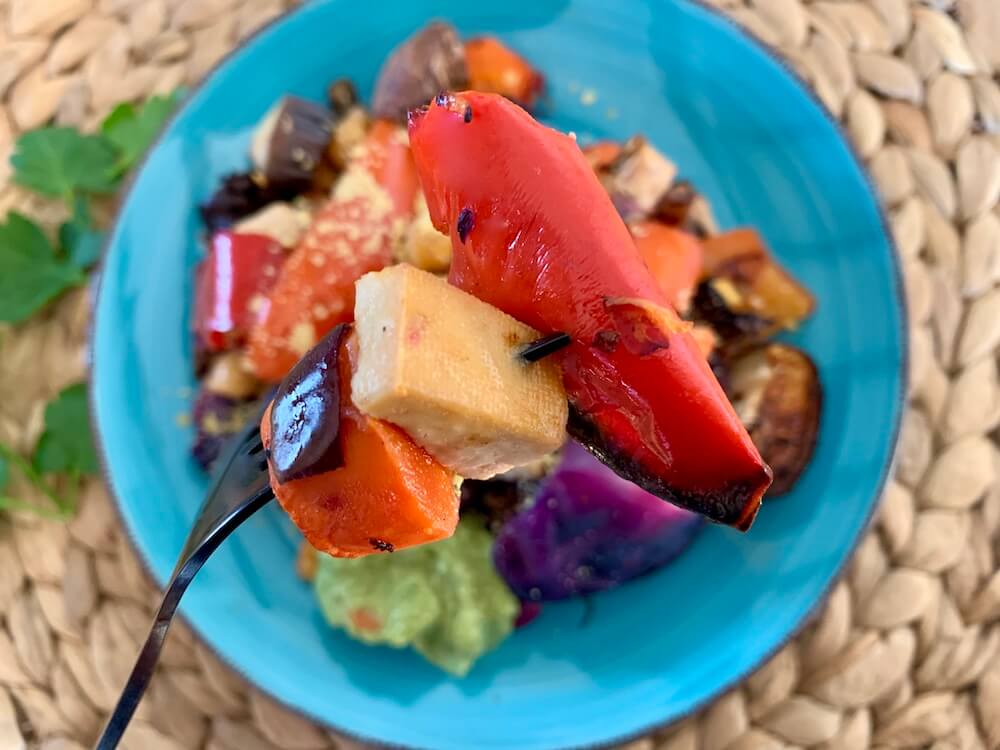Have you ever asked yourself, can I cook chickpeas in a rice cooker? If so, the answer is 100% yes. It’s easy!
There are a lot of things that seem like hassle before you start, then become effortless once you’ve got into them, right?
Like, when you decide to go whole foods plant based vegan and you find yourself just a tad lost, or you wonder why you’d give up oil in the first place?
Or how to roast vegetables without oil or how to fry in water instead of oil?
But once you master these methods, they switch in your mind from tricky to elementary.
And that’s the way it is with cooking chickpeas too.
Since discovering this way of cooking dried chickpeas, I don’t buy the pre-cooked chickpeas in a jar anymore (or very occasionally, like for an emergency), which is great for my shopping list, super for my recycling bin and even better for my wallet.
Table of Contents
Why Use Dried Chickpeas Instead of Canned?
Rewind a few years back and my cupboard was filled with jars of chickpeas. I used to think it would be too much faff to cook my own; too time consuming and too much planning needed.
Well, it isn’t. And I’m here to debunk those arguments for you.
Whether you’re making a snack of the most delicious hummus or fixing some chickpeas in coconut sauce for dinner, home-cooked chickpeas will always (and I mean always) taste better.
The bottom line is they’re healthier (no added salt or preservatives), cheaper, tastier, more suitable for many recipes (like falafel for example) and they create less packaging.
7 Reasons Why to Cook Your Own Chickpeas
- Homemade chickpeas taste much richer and more flavoursome than tinned or from a jar.
- Home-cooked cost a fraction of the pre-cooked variety.
- Homemade chickpeas are much healthier – because they don’t contain added preservatives.
- You have more choice – organic, creamy, extra large, local etc.
- There’s no added salt, which can be a problem for people with high blood pressure.
- Once you’ve mastered cooking dried chickpeas, they’re so easy to cook.
- Making your own chickpeas cuts down on household rubbish which is good for you and great for the environment!
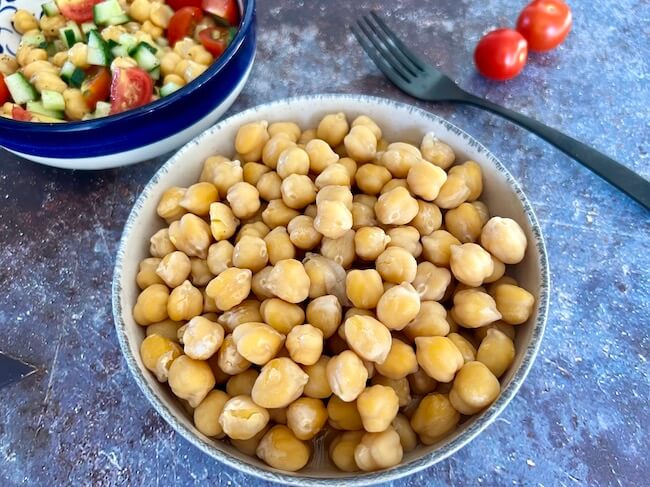
Do I Have to Soak Dried Chickpeas Overnight?
The easiest way to cook chickpeas is to soak them overnight, because that will speed up their cooking time.
Soaking also makes them more digestible by reducing the lectins in the chickpea, so it’s a good thing all round. Be sure to drain away the soaking water and rinse the chickpeas before cooking.
But what happens if you forget to put the chickpeas on to soak the night before?
No worries, there are other possibilities!
What if I Forget to Soak the Chickpeas Overnight?
Instead of soaking overnight, you can soak the chickpeas for a few hours instead. Put them on to soak in the morning, ready for cooking for lunch for example. The cooking time will be longer, but the chickpeas will still turn out fine.
If you don’t have time to soak them for a few hours even, then you can bring them to the boil and leave them to sit in the boiling water as it cools down.
Rinse the chickpeas and cook as normal.
Soaking the chickpeas (and even just bringing them to the boil but to a lesser degree) will also help to remove/disable the lectins which can cause digestive upset.
It basically makes the chickpeas more easily digested, though if you have a slow cooker, it is possible to cook and eat chickpeas which haven’t been soaked, especially once you’re used to eating legumes.
Tips for Soaking Chickpeas Overnight
Here are a few tips for soaking dried chickpeas.
- If possible use filtered water or soft water, as hard water can make the chickpeas come out harder themselves.
- Cook without salt and add salt to your final recipe rather than to the cooking process. Salt can also make the chickpeas harder.
- In warm climates, soak the chickpeas in the fridge.
- If you don’t have the option to soak them overnight, just soak the chickpeas for as long as you can and allow extra cooking time.
- Rinse the chickpeas and refresh the water before cooking as this will help make them more digestible.
How to Cook Chickpeas in the Rice Cooker
This is assuming that you’ve soaked the chickpeas overnight. If you haven’t, keep an eye on the chickpeas by opening the rice cooker to check and adding more water as necessary.
- Measure the dry chickpeas using the rice measure.
- Cover the soaked chickpeas in accordance with the rice instructions. So for 3 cups of fully soaked chickpeas, you’ll fill the water up to the same level as if it were for rice. This ratio will be more if the chickpeas are less soaked.
- Turn on the rice cooker as normal, but make sure to come back and check it after about the first 20 minutes and keep an eye on it so that the water doesn’t all evaporate leaving hard chickpeas.
- After about 40 minutes the chickpeas should be soft and ready for use.
- Switch off the rice cooker and leave them to sit in the steam for another 30 minutes or so if possible.
- If you want to soften the chickpeas to be super soft and have an extra smooth final result, add half a teaspoon of soda bicarbonate to the cooking water.
- Don’t ‘trust’ the rice cooker as you would with rice. Instead, keep a check on it and add more water as necessary.
- If the chickpeas are cooked through and there’s still excess water, no problem. Turn off the rice cooker manually and leave the chickpeas to steam and soften for another 15 minutes.
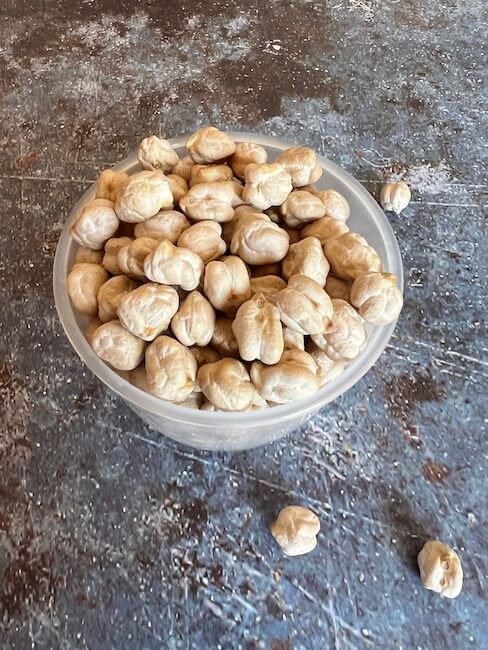
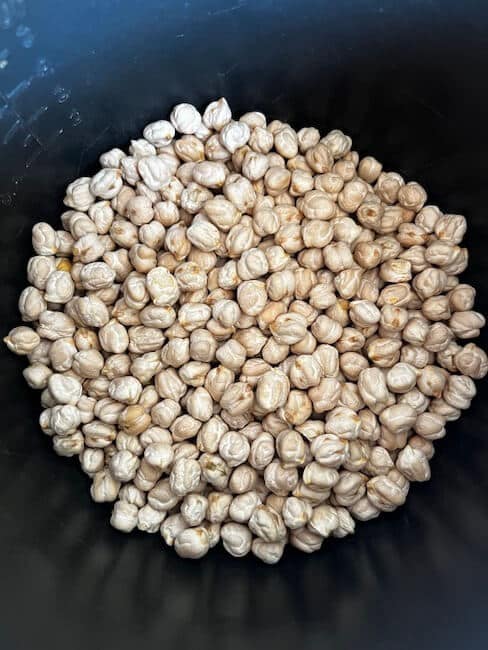

What Can I Make with Chickpeas?
There are so many delicious meals you can make with chickpeas!
- Of course it would ba remiss not to start out with the king of chickpea recipes and try making the best creamy hummus ever!
- Don’t limit hummus to just one flavour though, try making beetroot hummus, avocado hummus, roasted red pepper hummus, spicy hummus and more.
- Delicious roasted chickpea snack
- Easy Sweet Potato with Chickpeas in a Coconut Sauce
- Vegan Eggplant Curry with Chickpeas
- Chickpeas in salad
- Chickpeas in stews
- Chickpeas in soups
- And saving one of the best for last, of course, the queen of all chickpea recipes – falafel.
Should I Peel the Chickpeas?
It isn’t necessary to peel the chickpeas, but if you do, you’ll get a smoother finish. Chickpeas have a translucent skin, which makes for a more grainy hummus.
And believe me, there’s a LOT of that little skin in your bowl of chickpeas, lol! You’ll be surprised when you actually peel them how much quantity of peeling you get left with.
If you’re happy to spend a little time peeling the chickpeas, you have a couple of options.
Use Soda Bicarbonate in the Cooking
By cooking the chickpeas in soda bicarbonate, you’ll get softer chickpeas and the skin with break up and dissolve into the water.
You then need to rinse the chickpeas until all the bits of skin have gone.
Be careful not to block up your drain with this though as there’s a lot of skin that comes off each batch of chickpeas. See in the image below how much came from this one small bowl of chickpeas and now imagine that all broken up in your rinse-water.
Use Soda Bicarbonate After Cooking
Once the chickpeas are cooked, cover them in warm or hot water and add a teaspoon of soda bicarbonate.
Wait for a few minutes, then begin to swirl the chickpeas between your hands and you’ll see the skins begin to fall away from the chickpeas.
Repeat until all the skins are off, then drain and use.
Peel the Chickpeas by Hand
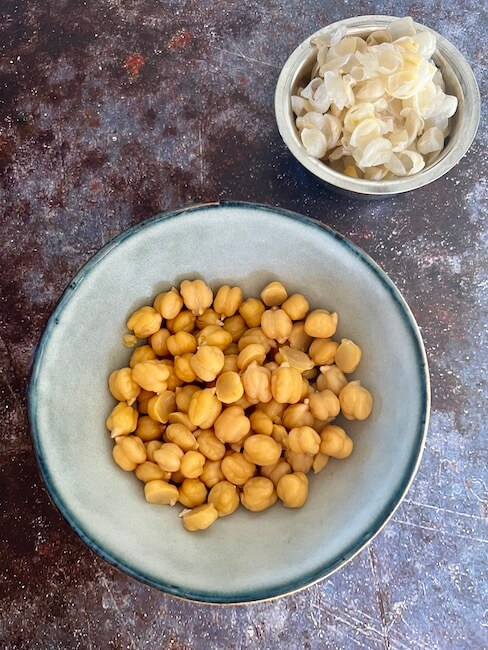
Fill the pan of chickpeas with cold water and rub them together, then individually pick up each chickpea and pop it out of its shell.
This works okay for small quantities, but it can be a bit tedious, especially if you’re preparing a larger quantity.
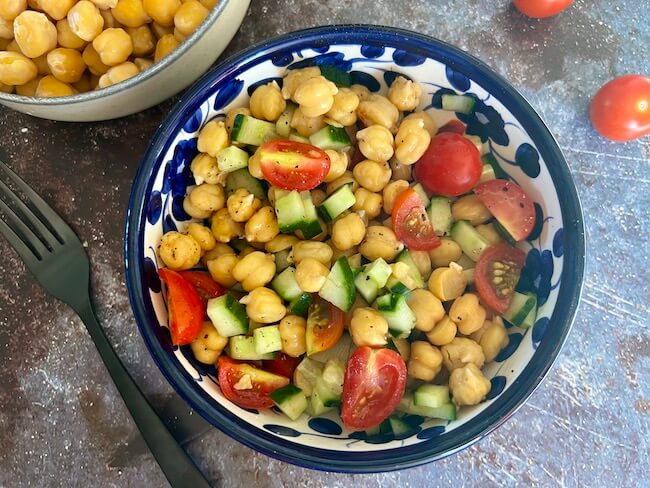
How to Cook ChickPeas in a Rice Cooker
Ingredients
- 300g dried chickpeas
- optional 1 tsp soda bicarbonate to make the chickpeas softer
- soft water or filtered water is preferable
Directions
- Soak the chickpeas overnight.
- Rinse the chickpeas.
- Use the rice measure to place the chickpeas into the rice cooker container.
- Cover with fresh water up to the same marker as for rice or a tiny bit more.
- If you’d like extra smooth chickpeas, add 1 tsp soda bicarbonate to the rice cooker.
- Turn on the rice cooker. Check the rice cooker after 30 minutes. If necessary, add more water to cover the chickpeas.
- Check the chickpeas again after 40 minutes. Bite into one to test how soft it is. If it isn’t cooked, leave it a few more minutes and keep checking.
- When soft enough, switch off the rice cooker and leave the chickpeas to sit in the heat for another 30 minutes (or until they cool down). This is completely optional and can make them a bit more juicy.
- Use the chickpeas to make you favourite chickpea recipes!
12 Reasons to Eat Chickpeas Every Day!
If you’re interested in keeping your gut as healthy as can be and nurturing a healthy microbiome, try combining your foods and including fermented foods. For example, if you’re having a spicy chickpea snack, you could serve some homemade sauerkraut on the side.
And if you’re serving a plain hummus on toast, try topping it off with a spicy homemade kimchi.
The question of how to cook chickpeas is just one of many common vegan FAQ which has a really simple solution. Chickpeas are easy to cook and they form part of an awesome whole foods plant based diet (WFPB).
I hope this answers the question of how to cook chickpeas in a rice cooker and that you get busy creating lots of delicious chickpea recipes!
